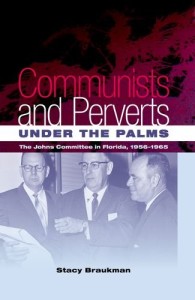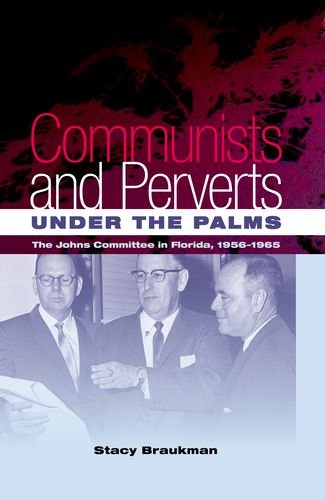 Communists and Perverts under the Palms:
Communists and Perverts under the Palms:
The Johns Committee in Florida, 1956-1965
by Stacy Braukman
University Press of Florida. 250 pages, $69.95
IN 1956, the Florida legislature established the Florida Legislative Investigation Committee (FLIC), which became known as the Johns Committee, with the vaguely stated mission to “investigate all organizations” whose activities were deemed “inimical to the well being and orderly pursuit of [citizens’] personal and business activities.” Stacy Braukman argues in Communists and Perverts under the Palms that their real mission was to “tarnish the reputation and hamper the efforts of the National Association for the Advancement of Colored People.” (Full disclosure: I knew Stacy Braukman when we worked together, before she began working on this book.)
Like the Red Scare and the McCarthy hearings, the Johns Committee worked on the assumption that the Civil Rights movement was the work of “outside agitators,” i.e. Communists, one of whose goals was mixing the races as part of a Communist takeover. Soon enough, however, homosexual activity appeared on the Johns Committee’s radar screen. And like the Communists, who recruited the young into their sinister ideology, homosexuals were after the children. This two-pronged threat of interracial dating and homosexuality became comingled in the minds of many Cold War politicians, however truly farfetched this notion appears in retrospect.
Braukman contends that Johns “used the committee to raise his own political profile … and, more nebulously, trying to defend conservative values.” Starting in May 1956, the Johns Committee investigated racial activism around the state by looking into a bus boycott in Tallahassee. By 1958, they had expanded their hunt to include professors at the University of Florida suspected of being gay. These investigations continued until the Committee was disbanded in 1965. Its highest achievement—which also contributed to its undoing—was the publication of a booklet titled Homosexuality and Citizenship in Florida, which sported a lavender cover, photos of half-nude boys and men, definitions of homosexual terms, and descriptions of how homosexuals cruised areas looking for “trade.”
And then a surprising thing happened: the booklet was vilified and ridiculed in many quarters. The editor of Miami News sneered: “The author of the tract did such a splendid job in No.1, Vol. 1, Florida Homo, that we shall never see No. 2.” By this time in 1965, the country was embroiled in the Civil Rights struggle, among others, and the Johns Committee was swept away accordingly. It issued one last report on the racial tensions in St. Augustine in the summer of 1965, which was not well received. By the time the report was issued, Charlie Johns had resigned from the committee that was commonly known by his name. Soon the committee itself would pass into history, but quietly, when the Florida legislature simply failed to renew its charter.
The Johns Committee was the official face of a right-wing movement that included the Ku Klux Klan, the John Birch Society, and the Christian Crusade, which was founded by Billy James Hargis. Undoubtedly they were well-versed in each other’s work and at times shared information. Braukman’s book provides a valuable genealogy of right-wing, anti-gay, and anti-progressive organizations—how they grew and gave birth to similar organizations. It is worth noting that Billy James Hargis of the Christian Crusade, who was a commie-hater early on, eventually resigned the presidency of American Christian College, a school he founded, after being accused of having sex with both male and female students. One of his employees was Richard Viguerie, a name that’s synonymous with the rise of the extreme right wing in the U.S. Since 1965, Viguerie has owned a direct mail business that has been used by almost every right-wing organization to advance the cause. Further research in this area should aim to expose the interrelated activities of these extremist organizations going back to the 1950’s, including their ability to divvy up their targets and yet maintain a cohesive vision for their America.





